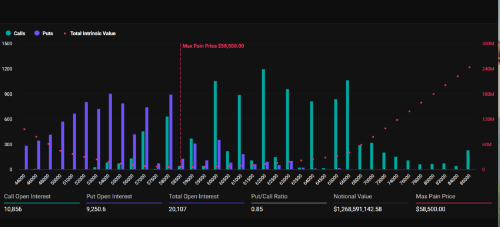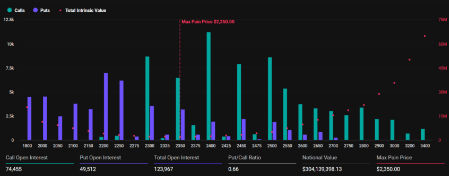As options on Bitcoin (BTC) and Ethereum (ETH) worth around $1.6 billion expire today, the cryptocurrency market is ready for further volatility.
The Federal Reserve has decided to lower interest rates by 50 basis points (bps), which corresponds with this occurrence.
Fed’s decision fuels the crypto market rally ahead of major options expiry
Deribit data indicates that 20,037 Bitcoin (BTC) options contracts with a total estimated value of $1.26 billion are set to expire on September 20. These contracts have a maximum pain point of $58,500 and a put-to-call ratio of 0.85.

The Ethereum (ETH) options market, with 125,046 contracts valued at $308.16 million, is also scheduled to expire. With a maximum pain point of $2,350, the put-to-call ratio of the Ethereum contracts that are expiring today is 0.65.

The price point at which option holders would experience the greatest losses is known as the maximum pain point in the context of options trading. It is effectively the price at which the greatest number of options—calls and puts—would expire worthless, causing traders to suffer the greatest amount of financial “pain.” Conversely, the put-to-call ratio compares the quantity of put options—bets on price decreases—to call options—bets on price increases—in order to determine the mood of the market.
The impact of the Fed’s move to lower rates was detailed in a recent study by Greeks.live for the crypto options contracts that are expiring today. The Fed’s action, according to the analysts, was mostly anticipated and in line with macroeconomic projections.
The Fed finally decided to cut rates by 50 basis points, exceeding the expectations of many macro analysts but largely in line with futures market expectations. The boots on the ground of the rate cut drove cryptocurrencies higher across the board, while at the same time U.S.… pic.twitter.com/QarKuGjsjI
— Greeks.live (@GreeksLive) September 19, 2024
Greeks, look forward.Additionally, live said that there will be two more interest rate meetings this year, on November 8 and December 19, at which point the market anticipates a total rate decrease of 100 basis points. There’s a chance that the next rate decrease may take place right before the US election, which would make further market turbulence likely.
According to research, the rate reduction this week has helped the cryptocurrency market. After the ruling, the price of Bitcoin shot up from $59,000 to almost $63,500.
In a similar vein, Ethereum had a notable rise around that time. According to data, ETH’s price soared from $2,293 to $2,482.
But as of late, both assets have steadied. As of this writing, the prices of Ethereum and Bitcoin are $2,450 and $62,890, respectively.
It is recommended that traders use caution despite the current trend. In the past, options expiry has frequently caused transient market volatility. The course of the next several days will be critical in determining if Ethereum and Bitcoin can continue their upward trajectories or if a correction is about to occur.
Tether’s transparency and business structure raises $118B FTX-like concerns
With Tether controlling more than 75% of the stablecoin market overall, worries about the stablecoin juggernaut’s sway over the cryptocurrency space are growing.
Investors are now concerned about a potential liquidity problem like to FTX from Tether, the $118 billion stablecoin monster, due to the company’s lack of third-party audits.
Concerns among investors over Tether, the company behind the biggest stablecoin globally, USD₨, are growing.
The most recent wave of worries was sparked by Cyber Capital founder Justin Bons, who expressed his worries that Tether may be an even greater hoax than FTX.
1/17) Tether is a 118 billion dollar scam; bigger than FTX & Bernie Madoff combined!
No proof of reserves & an audit has never been done; USDT is printing counterfeit money (fraud)
Caught falsifying documents, obscuring identities & lying about reserves
Stop using USDT now! 🧵
— Justin Bons (@Justin_Bons) September 14, 2024
Tether was hit with a $41 million civil monetary penalty by the United States Commodities and Futures Trading Commission (CFTC) in 2021 for falsely representing that USDT was completely backed by reserves.
Data showing that Tether’s market share has topped 75% of the stablecoin industry following a 20% gain over the previous two years has raised concerns about the stablecoin giant’s power over the cryptocurrency ecosystem.
A hypothetical Tether implosion would be banking-driven, unlike the FTX collapse
One of the most well-known black swan occurrences in the sector, the collapse of the FTX exchange, which resulted in the loss of $8.9 billion in customer assets, is a contributing factor in the worries.
According to Sean Lee, co-founder of IDA Finance, a potential Tether implosion would be tied to its banking partners, whereas FTX’s failure was caused by its inability to fulfill huge consumer withdrawals of $6 billion within three days.
Lee mentioned:
“Bear market or not, the possibility of Tether imploding is more about its structural connectivity to its underlying assets and banking rails, not so much market movement. Otherwise, USDT would’ve suffered during the last bear market, but instead, it was actually [USD Coin] USDC that depegged due to their reliance on Silicon Valley Bank and Signature Bank.”
Tether recognized client withdrawals of approximately $16.7 billion in USDT in May 2022 without any problems, all within a 10-day period.
However, in September 2008, Washington Mutual Bank experienced what is now recognized as the largest banking collapse in US history when it was unable to fulfill withdrawals totaling $16.5 billion in less than ten days.
According to some, Tether is too big to fail. Notably, author and international blockchain specialist Anndy Lian cautioned that while she doesn’t anticipate problems for Tether, such centralized organizations might generally be problematic for the bitcoin space:
“Cryptocurrencies were originally designed to operate without central control, promoting transparency, security, and user autonomy. However, Tether, as a centralized stablecoin issuer, holds significant influence over the crypto market due to its widespread use for trading and liquidity.”
Tether’s business structure and transparency raise concerns
On September 8, Tether made a $100 million investment in Adecoagro, gaining a 9.8% share in the massive Latin American farming company.
According to Cyber Capital’s Bons, this most recent investment provided us with the first revelation of Tether’s governance structure, writing:
“The board of Tether Holdings only has 2 members; Giancarlo & Ludovicos. This implies that the USDT reserves are still not segregated in 2024 & these two have absolute control!”
IDA Finance’s co-founder, Lee, was also concerned about Tether’s lack of transparency. He wrote:
“Tether is structured as a business and their insistence on not providing the level of detailed transparency that ensures real trust from the community and institutional players is indeed concerning.”
4/17) By 2021, Tether released an “auditor’s report” in partnership with BDO
However, an “Auditor’s Report” or an “Accountant Report” is not a formal audit at all!
Despite the claims, Tether has never submitted its alleged reserves to a real unrestricted, third-party audit!
— Justin Bons (@Justin_Bons) September 14, 2024
Cyber Capital’s Bons asserts that although Tether reported having reserves of more over $118 billion in its second quarter “independent attestations conducted by BDO,” Tether has not yet submitted its reserves for a third-party audit.
“However, an ‘Auditor’s Report’ or an ‘Accountant Report’ is not a formal audit at all! Despite the claims, Tether has never submitted its alleged reserves to a real unrestricted, third-party audit!”
Crypto exchange BingX suffers hacker attack, losses surpass $40M
Following a suspected hacker assault on its hot wallet, BingX has temporarily banned withdrawals; blockchain analysts estimate damages reaching $40 million.
After discovering a possible cyber assault on its hot wallet, Singapore-based cryptocurrency exchange BingX halted withdrawals; blockchain researchers estimate damages exceeding tens of millions of dollars.
BingX’s chief product officer, Vivien Lin, stated in an X post on September 20 that the breach happened at around 4 a.m. Singapore time on that day, which prompted the business to implement a “emergency plan.”
[🛠️ Temporary Wallet Maintenance Notice]
■ Schedule: ~24 hours
■ When maintenance is done, we will announce it through a notice.We sincerely apologize for any inconvenience this may cause and appreciate your patience.
Learn more: https://t.co/Tx8PE6H76Q
— BingX (@BingXOfficial) September 20, 2024
The exchange moved its funds to safe places, according to Lin. The exchange informed customers that the majority of its assets are kept in cold wallets, which were unaffected by the hack, but stated that the damage is still being estimated. Although Lin does not know the precise scope of the attack, there was a “minor asset loss.”
“There has been minor asset loss, but the amount is small and still being calculated.”
Vivien Lin


